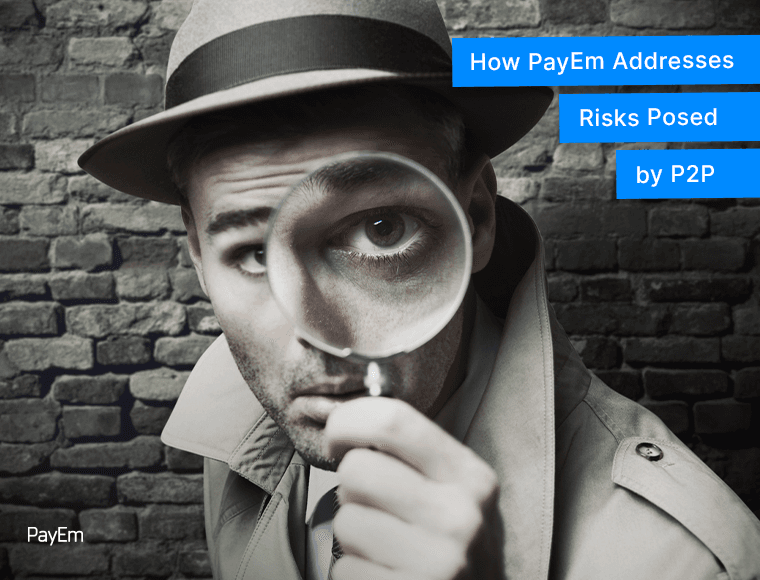November 03, 2022
How PayEm Addresses Risks Posed By P2P

Sign up for our newsletter
Stay informed with the latest trends and best practices in finance and procurement.

For a moment, imagine a business operating without procurement. Unless said business is vertically integrated, totally independent of the need for vendors or suppliers, chances are high that, without procurement, day-to-day operations would come to a complete standstill.
On both large and small scales, procurement often goes through a process colloquially known as P2P, or procure-to-pay. The specific steps embedded within P2P may vary between organizations, but ultimately, it suggests a link between accounts payable and procurement, enabling the smooth operation of internal procurement processes.
To illustrate P2P more clearly, PayEm defines it as comprised of three main steps:
- Requisition, in which an employee requests financial permission to move forward with the procurement arrangement
- Approval, in which the employee receives said permission
- Purchase Order (PO) Creation, in which paperwork is completed to confirm the payment of a supplier or vendor for the sake of procurement
As simple and straightforward as P2P may seem, the devil’s in the details. Indeed, there’s much missing from the P2P paradigm. These missing elements and their associated risks hold P2P back from excelling as an institutional standard for procurement. Luckily, PayEm stands ready to mitigate said risks, which are outlined as follows:
Poor Spend Visibility
Spend visibility is central to the long-term health and iterative improvement of a business’s procurement process. Though it possesses utility, P2P is limited in scope, such that it does not include procedural elements that enable high-level, analytical perspectives. As a result, businesses experiencing poor spend visibility must endeavor to identify solutions that inspire data-driven decision-making.
In addition to its procurement capabilities, PayEm mitigates the risk of poor spend visibility by offering a full spend management feature suite, one which permits more efficient vendor management through the use of dedicated virtual cards and customizable budget limits.
Non-Compliant Vendors
The procurement-centric relationship between businesses and their vendors, central to P2P, is frequently the lynchpin between corporate growth and collapse. Contracts must be iron clad with a general presumption of good faith, given the relationship’s essential status. However, this is not always the case, with contract violation and general non-compliance sometimes occurring. These instances are often due to errors stemming from the initial negotiation and contract based on incorrect, incomplete, or outdated data.
PayEm limits these risks by providing users with robust vendor management capabilities, including the ability to issue vendor-specific virtual cards. Moreover, with PayEm’s automation tools, finance teams can adjust their focus towards vendor oversight and away from manual, repetitive tasks. Since the platform offers access to financial data in real-time, the danger of outdated information affecting vendor contract negotiation is eliminated.
Invoice Fraud
When a company’s procurement solution begins and ends with P2P, without measures to secure from criminal intent, cases of invoice fraud can occur. In this case, invoice fraud refers to an employee or vendor submitting an invoice for payment or reimbursement for a charge that never existed. Not only does this cause legal and financial headaches, but it generally fosters an air of distrust.
This risk is automatically done away with when using PayEm’s platform as a solution for corporate credit cards, purchase orders, reimbursements, or spend requests. More specifically, every detail of every expense is automatically recorded and matched in the platform or mobile app, then synced with the user’s ERP. In turn, this takes reconciliation to a whole new level, with context for every transaction created upfront, without the need to chase receipts.
Human Error Via Manual Processes
For laypeople and experts alike, procurement is no elementary subject. When a typical, manual P2P system is in place, mistakes happen. A simple extra zero on a purchase order can have disastrous consequences, as can a missed log of whether goods or services have been delivered or received.
The PayEm platform resolves this risk from the get-go by taking human error out of the equation with automation. Taking various forms, PayEm’s automation capabilities enable automatic reconciliation, ERP synchronization, amortization, bill payments, cross-border transfers, and accounts payable. When all is said and done, the entire P2P process, from procure to pay, will be centralized, automated, and trackable. With real-time data available to you at any time, errors, redundant elements, and compliance issues are fully mitigated while staying on budget.
Inadequate Data Governance
Tracking data and keeping it updated in real-time isn’t just crucial for procurement, but rather a broader element in a complex legal framework, namely Sarbanes-Oxley or SOX. If a company’s P2P systems are not adequately updating or archiving data - for the sake of lawsuits or audits - then the company as a whole could violate federal law.
When even a shadow of SOX risk presents itself, responsible companies need to adopt new solutions quickly, or else they need to prepare for the unemployment line. Along with its SOC II compliant designation, PayEm, by its very nature, should ease SOX concerns for its users on the grounds of human error, fraud, and other potential pitfalls outlined previously.
From P2P to R2R
Though PayEm’s connected finance platform can resolve many risks posed by a P2P procurement ecosystem, the fact remains that P2P is inherently a limited and outmoded procurement method. Sure, requisition, approval, and PO creation remain essential, but not at the expense of other elements that have become equally so in recent years.
That’s why PayEm has done away with the P2P moniker, opting instead for R2R or request-to-reconciliation. Taking a much broader view than P2P, R2R includes elements preceding and following the three parts of procure-to-pay, thereby expanding the total to seven. The four new actions included by R2R are as follows:
- Request, preceding requisition, in which employees request funds
- Payment Method, following PO creation, in which a vendor card is issued or bank account details entered
- Transaction, following payment method, in which the planned transaction takes place within budgetary limits
- Reconciliation, following transaction, in which transaction information is matched with invoice submissions, then synced with the company’s ERP or accounting software
Just as the FinTech industry has evolved in recent years, so too must procurement. With so many risks associated with P2P, the dynamic needs to change, and R2R is here to meet the challenge. For all inquiries, procurement-related or otherwise, PayEm’s experts are available to offer a comprehensive, no-cost demo of the platform.


